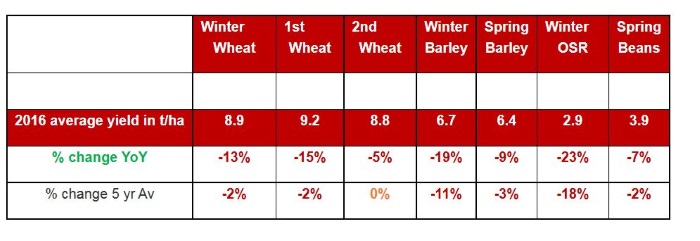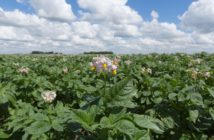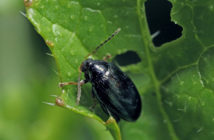Strutt & Parker has published the results of its 2016 Harvest Yields Survey which offers a valuable insight into the performance of combinable crops this season.
The survey covers 54,000 ha, spread over 129 farms mainly in East Anglia, the South East and the Midlands, including farms managed by the firm and where the firm has agronomy input.
According to provisional results, the overall winter wheat yield for 2016 was 8.9t/ha, which although down 13% on last year’s record average of 10.2t/ha, is closer to the five-year average of 9.1t/ha.
First wheat yields averaged 9.2t/ha, only 1% down on the five-year average but starkly 15% down on the memorable 2015 harvest. Second wheats averaged 8.8t/ha, which is 5% lower than in 2015, and the same as the five-year average.
Strutt & Parker agronomist Jock Willmott said: “Matching 2015 yield was never a reality, the season started off very slowly and for many too much rain in the latter stages of development hampered yields.
“Foliar disease has been an issue culminating in some potential yield and quality loss through ear disease. Lack of grass weed control has had a fundamental impact on yields in some areas, reducing yield through either direct competition or late season crop destruction. Overall, second wheats did seem more consistent than first wheats, possibly due to later drilling and lower disease pressure, but more likely due to higher total nitrogen use.”
Data from the AHDB Recommended List trials for the East, showed the majority of varieties held true to their five-year mean potential, noticeable performers include Crusoe, Cordiale, and Evolution performing ahead of the five-year average, with JB Diego, Zulu and Santiago maintaining their consistency.
The same data pointed to Skyfall performing 3% below its five-year mean and Trinity was down by 2%. Strutt & Parker’s farm level data also points to Skyfall yielding 2% lower than Crusoe with both achieving full milling specification.
Mr Willmott said: “Unlike last year where all crops yielded well, this year had some noticeable underachievers, in particular oilseed rape. On the farms surveyed, oilseed rape had its lowest performing year since 2004, with average crop yield 18% down on its five-year mean and 23% down from 2015.
“The yields came as an unwelcome surprise with crops at desiccation time not appearing to look poor. In the east, crops struggled to establish under the pressure of pyrethroid resistant adult Cabbage Stem Flea Beetle (CSFB), even in counties where emergency approval was granted for neonicotinoid seed dressing.
“Additionally, the damage caused by larvae of the CSFB led to stunted growth and premature senescence. A long flowering period and reduced solar radiation (309 sunshine hours for May/June compared with 426 in 2015, Met Office Oxford) also led to fewer seeds per pod and smaller seeds.”
Oilseed rape yields averaged 2.9t/ha, contributing to a shortfall in cashflow and indecision over the crop’s future.
For many growers, winter barley was also a casualty of the 2016 growing conditions – yielding on average 6.7t/ha, 11% lower yield than the five-year average, owing largely to low seed numbers and seed weight as a result of the slow spring and subsequent growing conditions. For some, BYDV had a considerable impact on yield as a result of insufficient aphid protection. Both six-row hybrid and two-row conventional varieties were equally affected with local site conditions having a greater bearing on final bushel weight.
The data also shows that spring barley yields eased back to 6.4t/ha, with the gap narrowing significantly against winter barley, supported by better bushel weights and in general a marketable quality.
Winter beans proved to be the only crop that bucked the yield trend, with average yields rising. “Good establishment and the mild winter led to good plant development. Chocolate spot incidence was high, but did not reflect in yield results. However, quality has generally been poor with high bruchid beetle damage.”
Spring beans and peas both appeared to have suffered as a result on the late spring and slow mid-season growing conditions with spring bean yields 2% down on five-year trends.
Overall, Mr Willmott said the results pointed to an average harvest with growers grateful for the quality.
Looking to the future, he suggested the inclusion of oilseed rape in the rotation would continue to cause concern as would the perennial issue of blackgrass containment.
“With a forecast gross margin only £60/ha higher than spring beans, growers will be seriously questioning oilseed rape given its additional management requirements. The early harvest and good first wheat entry is important for contract farms and large operations, but compared to spring beans, the variable costs are front loaded and paid at a time when cash flow is tight,” he said.
“For farms needing to beat blackgrass and following a wheat – wheat – oilseed rape rotation, we now recommend a new five course rotation with a double spring break. This is winter wheat – spring barley – spring beans – winter wheat – oilseed rape. Use the plough one year in four or five as a ‘reset’ button to maximise annual seed decline and avoid slackening herbicide inputs on the break crops. The most successful farms keep a steady consistent rotation and employ the plough.”




